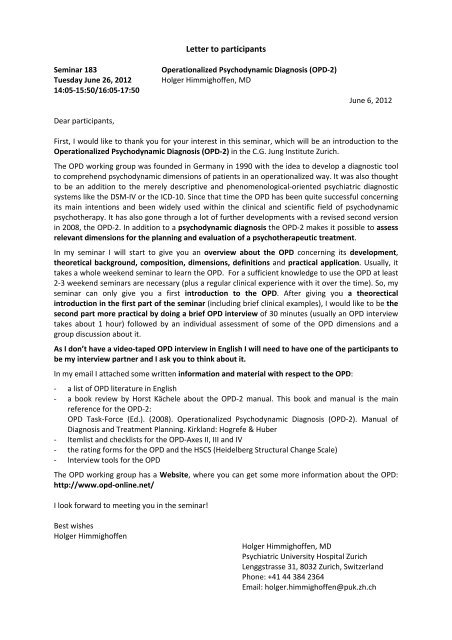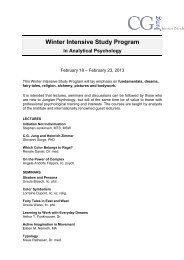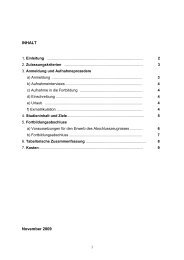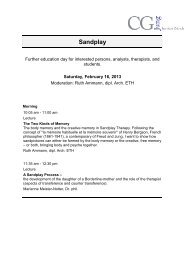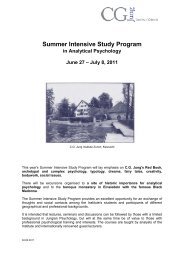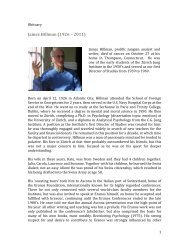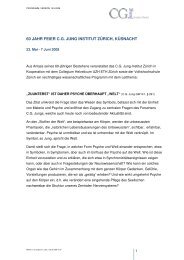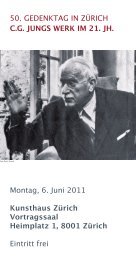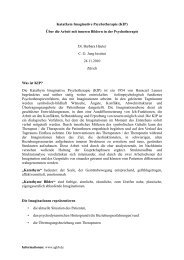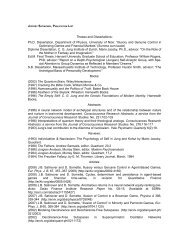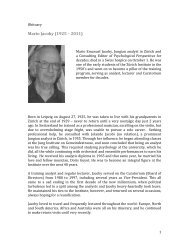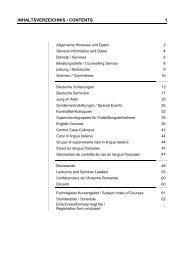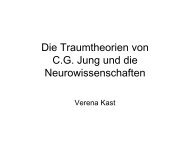Letter to participants - C. G. Jung Institut Zürich
Letter to participants - C. G. Jung Institut Zürich
Letter to participants - C. G. Jung Institut Zürich
You also want an ePaper? Increase the reach of your titles
YUMPU automatically turns print PDFs into web optimized ePapers that Google loves.
Seminar 183<br />
Tuesday June 26, 2012<br />
14:05‐15:50/16:05‐17:50<br />
Dear <strong>participants</strong>,<br />
<strong>Letter</strong> <strong>to</strong> <strong>participants</strong><br />
Operationalized Psychodynamic Diagnosis (OPD‐2)<br />
Holger Himmighoffen, MD<br />
June 6, 2012<br />
First, I would like <strong>to</strong> thank you for your interest in this seminar, which will be an introduction <strong>to</strong> the<br />
Operationalized Psychodynamic Diagnosis (OPD‐2) in the C.G. <strong>Jung</strong> <strong>Institut</strong>e Zurich.<br />
The OPD working group was founded in Germany in 1990 with the idea <strong>to</strong> develop a diagnostic <strong>to</strong>ol<br />
<strong>to</strong> comprehend psychodynamic dimensions of patients in an operationalized way. It was also thought<br />
<strong>to</strong> be an addition <strong>to</strong> the merely descriptive and phenomenological‐oriented psychiatric diagnostic<br />
systems like the DSM‐IV or the ICD‐10. Since that time the OPD has been quite successful concerning<br />
its main intentions and been widely used within the clinical and scientific field of psychodynamic<br />
psychotherapy. It has also gone through a lot of further developments with a revised second version<br />
in 2008, the OPD‐2. In addition <strong>to</strong> a psychodynamic diagnosis the OPD‐2 makes it possible <strong>to</strong> assess<br />
relevant dimensions for the planning and evaluation of a psychotherapeutic treatment.<br />
In my seminar I will start <strong>to</strong> give you an overview about the OPD concerning its development,<br />
theoretical background, composition, dimensions, definitions and practical application. Usually, it<br />
takes a whole weekend seminar <strong>to</strong> learn the OPD. For a sufficient knowledge <strong>to</strong> use the OPD at least<br />
2‐3 weekend seminars are necessary (plus a regular clinical experience with it over the time). So, my<br />
seminar can only give you a first introduction <strong>to</strong> the OPD. After giving you a theorectical<br />
introduction in the first part of the seminar (including brief clinical examples), I would like <strong>to</strong> be the<br />
second part more practical by doing a brief OPD interview of 30 minutes (usually an OPD interview<br />
takes about 1 hour) followed by an individual assessment of some of the OPD dimensions and a<br />
group discussion about it.<br />
As I don’t have a video‐taped OPD interview in English I will need <strong>to</strong> have one of the <strong>participants</strong> <strong>to</strong><br />
be my interview partner and I ask you <strong>to</strong> think about it.<br />
In my email I attached some written information and material with respect <strong>to</strong> the OPD:<br />
‐ a list of OPD literature in English<br />
‐ a book review by Horst Kächele about the OPD‐2 manual. This book and manual is the main<br />
reference for the OPD‐2:<br />
OPD Task‐Force (Ed.). (2008). Operationalized Psychodynamic Diagnosis (OPD‐2). Manual of<br />
Diagnosis and Treatment Planning. Kirkland: Hogrefe & Huber<br />
‐ Itemlist and checklists for the OPD‐Axes II, III and IV<br />
‐ the rating forms for the OPD and the HSCS (Heidelberg Structural Change Scale)<br />
‐ Interview <strong>to</strong>ols for the OPD<br />
The OPD working group has a Website, where you can get some more information about the OPD:<br />
http://www.opd‐online.net/<br />
I look forward <strong>to</strong> meeting you in the seminar!<br />
Best wishes<br />
Holger Himmighoffen<br />
Holger Himmighoffen, MD<br />
Psychiatric University Hospital Zurich<br />
Lenggstrasse 31, 8032 Zurich, Switzerland<br />
Phone: +41 44 384 2364<br />
Email: holger.himmighoffen@puk.zh.ch
a-<br />
a-<br />
a-<br />
a-<br />
a<br />
a<br />
a<br />
'''-:.}-:.:.:<br />
l:.fi<br />
-<br />
t'l<br />
t;<br />
13.2<br />
Axis ll<br />
13.2.1<br />
Item list axis interpersonal relationshipr<br />
t<br />
gt<br />
tü<br />
t<br />
r!<br />
A/O<br />
!B<br />
.I(u<br />
Ē<br />
f<br />
tr Er!<br />
b<br />
a-<br />
6,<br />
Ḻ<br />
# Ut<br />
b<br />
-ṯC'<br />
C'<br />
gt<br />
üt<br />
E<br />
.I cl L(l,<br />
3L xo,<br />
t<br />
- CI t- rLE<br />
\<br />
c,<br />
a-<br />
l--<br />
a<br />
6<br />
t!<br />
t!<br />
IE<br />
oo<br />
t!<br />
(l,<br />
aȳ Ē<br />
-t ẸE<br />
(l,<br />
.= (u rrt<br />
*oo<br />
ulä§<br />
ḇ b<br />
a-<br />
#,-<br />
Yt<br />
b<br />
ot<br />
--{JCr<br />
- a )<br />
=L<br />
o* b<br />
C'<br />
.E aCl<br />
r^<br />
TI<br />
h<br />
,E<br />
B<br />
Ct<br />
f<br />
ḇr<br />
- (u 5<br />
'-<br />
ḇ<br />
.I--yr<br />
C'<br />
iJ<br />
t c,<br />
a-<br />
b<br />
c,<br />
IL<br />
x(,<br />
rb<br />
E<br />
t<br />
tE<br />
CI<br />
:.:.1 5.il:.: :,:.: i<br />
.: :-lf ;:;:;l:l:::l:l::<br />
- .'a-:.:.:::-:.1:'<br />
. ,:<br />
-::.: :.-::..:.:<br />
::::t Gr':::::::::::l::::<br />
:.i:- r::: if::.<br />
':!it:::::: :':::.:::: j<br />
.:.'::,li:l::i::.:i::l:<br />
..'.'I.1:.i:.!i<br />
:::::el::.:::::<br />
:'::,:tr,., :,::i:<br />
.::16l ,<br />
.:.llt--.-.:.:::<br />
:,::::<br />
.:::::I::::i:<br />
':;i'.}i;i:-:l.:'<br />
i::::<br />
':':"al:::::::::: :l<br />
.,.',Ei,,,....'i<br />
.:..}It-il:-:.i.''!<br />
:.:.;.:-l-..i1:;:1ll<br />
vt<br />
(U<br />
E<br />
u<br />
t- r}-<br />
rrl<br />
.9<br />
(tl<br />
(U<br />
u,<br />
§o<br />
.E<br />
*.<br />
(U ttt<br />
ä.,E<br />
sä<br />
Et<br />
><br />
E-<br />
.-=<br />
*tio(u<br />
fE#<br />
EE .= r§ tJ vt (u --<br />
(Ur0 -c<br />
=(f<br />
bä<br />
ECL HE EE =o. -Et E.E @= =-= -f§EI' 5ep go8 (u.E<br />
I- L-<br />
üü c)E<br />
sä S +-'<br />
r-E o-E<br />
rrt C<br />
Y<strong>to</strong>o<br />
99 >\.= 'trt ds<br />
_8 .B<br />
>l O -Er<br />
aoE sp C.l(u =<br />
=(u dI :c gE xoo<br />
(§t<br />
ur<br />
E<br />
bäP<br />
.§s .=<br />
§:E<br />
--<br />
r§<br />
L-<br />
,üE<br />
ü2i -<br />
.= icl (§ .BC<br />
.E<br />
trDc §-= Eä<br />
g# > -st +.5 =o (u- =(U<br />
:E: 99 oo Btro<br />
rEg .= --<br />
>.= .= §! epä l-, O<br />
'-' t- u .l-r rrl<br />
.rr fl(f<br />
.E<br />
< cJ .=<br />
H$ s§,<br />
üep §B (§ \r= or= öE<br />
oO E, <strong>to</strong><br />
-c(u tro.=<br />
.it) *, gP<br />
Ppä bo.= '=<br />
Pqoo<br />
<strong>to</strong><br />
F*t<br />
ä= =E<br />
(§ tq, (ufu<br />
L. L,<br />
O{ c, -cl -SI .E §§ E§ EU<br />
.cl r§ =.§ '= '?i ao(u ts '=i epu<br />
.i-l (U E.E<br />
L- +,<br />
{Jl-<br />
al,<br />
rEC<br />
E()<br />
§iu ()(u 'i; (} r!*<br />
L' E' -ll'e, oä (u= =+ OE<br />
äs<br />
E§<br />
-<br />
-cl -o fiä =o EE<br />
F({ rn
I*6 13. Tools for Working with OPD<br />
(onfl ictua I rtress (rtressor-i nd u (ed conflict)<br />
-9r<br />
^ts"s suesaer*m : üla* 1lie,l1st;ix"mOgtl0<br />
#ti#tq J ssnt aamrrru*, ffi<br />
ffi,är&ffi-,ü+är,r*ffiaoi.a,*i ,ffi<br />
.i'*ffi# i n'lr+ffi<br />
tiomt<strong>to</strong>rflffihttdtertilo$,atdthdcxteffräfutuiessoränU#ltirtälattäület.etpüiüer'"jr,'".i,".1{lf{;rt'k<br />
anO;in qaost"ire*Utültl*ralty,*,<strong>to</strong>@*** tfti oiiin.iftgI:r, @mef mm*<br />
,,,lte, adrrd"d,cdnflre musmpuimreäiiffi#ffipoittrau UnrorUdrtn+Sot- ,, r*i*ffi<br />
;fryr*M"g*ssessl$,be'*#@try[@in,gnä" ,p":r"Sidd*,#ti,:; '.*,-<br />
'.' .. ", .;6f,+,$iffi;<br />
Ät<strong>to</strong> tneintensiti$ .m*lüctriteräfoittre,ffiiffiuälartasofltffitheueqrrspirfUtstmrriteftifü ufl I ä,tcä s o-t llte,, th eJ co r res pofl d,<strong>to</strong> the, crite ria,lori, eqi;<br />
aeüänüinfi, oi *'n uff äii tio hfl gitäil, ii,ä:äil+<br />
fi Indiuiduation uersus dependency
13.3 OPD-2 Conflict Checklist 359
13.AThe oPD-2 structure checklist 361<br />
Ḻ<br />
a-o<br />
#<br />
uEL (u fr,<br />
.L<br />
'(u<br />
Fä<br />
EL<br />
*, tJ (u<br />
a-<br />
.cl'<br />
oaa<br />
h<br />
IH<br />
.I<br />
-.Er<br />
ilr<br />
t§<br />
c,<br />
a-<br />
#<br />
.I<br />
t-<br />
b<br />
('<br />
uo<br />
t,<br />
'Fl<br />
a<br />
IF
tr3.4 The OPD-Z Structure Checklist 363<br />
SL<br />
.I<br />
- rä<br />
Ḻ<br />
o<br />
af<br />
*J<br />
T tE<br />
C'<br />
L I<br />
# L'<br />
C'<br />
.L<br />
st'<br />
C)<br />
r*r<br />
(,<br />
Ḻ<br />
C)<br />
OI<br />
# fE<br />
-E-* d<br />
§o (u<br />
&<br />
aa<br />
Ḻ<br />
o<br />
.T {r,<br />
!E<br />
- =uo<br />
a,<br />
L<br />
r:<br />
C,<br />
k<br />
h<br />
# a3 fr,<br />
rE §L<br />
fit<br />
IJ<br />
GI<br />
a<br />
FI
,bt[ 13. Tools forWorking with OpD<br />
f<br />
L<br />
o<br />
.I<br />
fl<br />
'EU<br />
tr<br />
E rJIhL<br />
E LC,<br />
rJ<br />
- IE Ḻ L(u<br />
!ar,<br />
Ḻ<br />
- aa<br />
IH<br />
.I<br />
-.I<br />
.§l<br />
r§<br />
-r!<br />
§<br />
o<br />
.I<br />
# ot-<br />
E<br />
llt<br />
F a<br />
fi.t
f<br />
,OO 13. Tools for Working with OPD<br />
UT<br />
fl tJ<br />
ü<br />
.I<br />
.tl'<br />
o<br />
I<br />
TE<br />
L (u *Ė<br />
I<br />
aa<br />
tar \,<br />
n§<br />
TL<br />
l§<br />
U<br />
*,<br />
J<br />
L<br />
(u<br />
Ē<br />
I<br />
-L'<br />
tr§<br />
fl<br />
rH<br />
{<br />
F:<br />
qf
f<br />
*i:<br />
I : i::,: . il:: :r::: :. .:<br />
ll<br />
;:i: ::<br />
'- : , .r .:: 1 ... ::r.<br />
:r.:,r:::ri:]<br />
:rt: :1:ii:r.:l:,1 .,::1:<br />
':<br />
',i<br />
: r1a,:::r:::::ij: :<br />
i<br />
l3.4The OPD-2 Structure Checklist 361<br />
a:i:::: ::::: I :.<br />
:t:r ::::':r::i:t:<br />
r:r:l<br />
::.|.. :::::':]:<br />
t/t;<br />
:<br />
.':::. :r:<br />
I r:: it.:i rr : I<br />
::::,i::: i:i::- :::.:<br />
,::, , :,,,.i:, i:t ,,],.t,.::,<br />
,':i:.-', i<br />
j:j::::::r :::::1:::<br />
:,..::irl trl: ::r::1;<br />
,:r, :r'.:::::::.i.iir, r:il:.i<br />
'.,] ,,: .i. ] ::<br />
,..i''1.'...',i.,i<br />
u.ii,.i<br />
.1.,,,'".i<br />
r,t<br />
rlr,<br />
[,<br />
(u<br />
t-<br />
.cl'<br />
o<br />
r<br />
n§<br />
l Lb<br />
(u<br />
rP<br />
x<br />
lrt<br />
aa<br />
h<br />
rlj<br />
.I<br />
L'<br />
t§ EL<br />
TE<br />
t,<br />
rE E<br />
CÜ<br />
ta<br />
L<br />
- TJ<br />
trt<br />
vrL,<br />
GI t<br />
Ef
368 13. Tools for Working with OPD<br />
13.5<br />
Heidelber§ $tructural ftanse §catre
Slll 13. Tools for Working with OPD<br />
: .<br />
. ,:. .,<br />
1'. ,,:::
372 13. Tools for Working with OpD<br />
f .,Djel"lfl.e-i{'lFf,vJ"el11r{lttreffi 1otr§g-p Je,taüqqship trrraneCIlris/l.her.or+m:qrnerrmqlons qnü$tiereq<br />
,,:tiöYrsof.th6lnhiäc,tirinde#nrrsttf+hp'äirra<strong>to</strong>i*idc+ritha+lü,rhe.#;;+,{i}' - ."i';;' ' . "- ;i* :-'<br />
13.6.3<br />
§rtteru§ew tso§s for &xäs §§§<br />
Perception of conflicts and affects impaired by meanr of defence
,74 13. Tools for Working with OPD<br />
§trersor-induced conflict<br />
",,,liws ffifurffiHtgdd, ffit tjl:t:tffiffie ,a'teriipqäli<br />
pg,@en,,<br />
- ;e0@ffi;.":i".i.':"9.rf.1',+;; ,*'r.i,j',r',.;i;'f::,:- ,§ö dfo i'e, {ifi:ai,,,eJr,t;<br />
:i:' i,.::e-."i':?tii,":;ii+f'.,,t*,, .1;r.;,;ii<br />
j;;;'1,; t<br />
hiftrg' ffi,fifulen"g'<br />
fffffirffi
:i:<br />
,l::: ::t.<br />
: :<br />
1-r: i :<br />
,ii:r::tt:..l:',,,,,.::<br />
ti:i!:.r<br />
:j',I:':'l:,:|:<br />
::l :::<br />
j:<br />
:1:l::::tt::t:::::::<br />
,::l:,:,:,:,t<br />
:':,,,,,<br />
ii .,., ,.,.,.,.:,'.<br />
,:i::,',:,<br />
::ititi:i:::t 1<br />
:t: | .. :<br />
.titttl<br />
rili::::r::<br />
t:i<br />
. i...t:<br />
.i::l'i:":."<br />
:i,l i:::i::l<br />
,ltttiit:i:j::::: :<br />
ltt:tt:ltit:::t:r ::: :<br />
iiiltltlt:t::::t:: . :<br />
:::l:rri:::::i::::.<br />
l<br />
::i:ir:r;ri::r:::rr :<br />
..itl<br />
i::ilijili,i::t.:.:,:,:<br />
: i:<br />
| | | i<br />
| i | | : r i : : : : : :<br />
::1....:.<br />
t:.:::::,:_<br />
i:l.l.l.:':'l<br />
:i t,: ":r<br />
:<br />
iirirli:iirirrrr::<br />
l',,jiiiriirrrrtr:.r.:<br />
.iilril,:.:'<br />
::;t i j i i t l :; l: i<br />
i t .<br />
l:ltl:ltlrl':<br />
rliltiritiilili,,,,,<br />
.:illi:liltltill,:,a','<br />
i,iii.i,l'l,'.....<br />
..<br />
.:i1:::i,tttitl!. :<br />
'<br />
r<br />
tÜU 13. Tools for Wbrking with OPD<br />
C5. Oedipal conflict<br />
l:i:.:il':ltllt:i.<br />
,,i:::l,,llll:lll,,:<br />
: i: r i i i i i i : : : : :: : : :<br />
:ii.,:,:,:,:,::l:, ,<br />
i,l',,.'.'.'..<br />
j:::t:):): tt.::t.:: :<br />
l l': : r: :'<br />
:j:t:.:j]. . ' "<br />
.iiiiiliiiiii:iiii.i<br />
,'llil,ill lltl l:,.'<br />
itlriiiiirr:rr : ::<br />
l ll<br />
i:i::::::::::<br />
:la,.ltttttt:t:: : :'<br />
[iiiii,iiii.lii.<br />
tiliiiitiiiiliiri i l<br />
'fi<br />
,riiiiiiiiiiiiiiii.
3üZ 13. Tools for Working with OPD<br />
(7. ldentrty conflict<br />
13.5.4<br />
ümäerulernr <strong>to</strong>o§s for Axis äU<br />
1.1 (ognitiue abilitier: §elf-perception
13.6 Interview Tools 387<br />
§hts"'häffi<br />
thcteaqqBere. !+<strong>to</strong>f'protegPp.,9f the ielationstip,trrdEs:si!fuffiütffe':ffif'pn more dlffriil<br />
3.1 Emotional ability: Internal (ommunication
4.I Attachment capacity: Internal obiects<br />
13.6 Interview Tools 389
13.5 Interview Tools 391<br />
Hffi'Ii*'*<br />
''.:, ]I:*:rffit*.<br />
Arn${rffl4Wrr@o" il?p.efideWk#he.r@nffiEt seqqfä "manft*with t}re eatient.oseilHtine hC,<br />
twea*,glq.'f dffinnnä"jtr&nomy4"tffu.§trffiunil+'opec lr.,iii*Wrttittrr*rtgl
,9;l 13. Tools for Working with oPD<br />
f, rj[,11i,T1,'l';,',f f svchodvnamicDiagnosis(0PD'2]Data<br />
Axis I - Experience of illness and prerequisites for treatment<br />
Basir module<br />
0hiectiue assessment of the illnesr/the problem<br />
Patient't experience, presentation, and con(epts of illness
i::<br />
r-<br />
lit<br />
13.7 Operationalized Psychodynamic Diagnosis (OPD-2)DataEvaluation Form 393<br />
Resour(es for and impediments <strong>to</strong> change<br />
Psy{hstheräpy rmCIdu§e {oBtsoma§}<br />
Patient's experlen(e, presentatioil, and (on(epts of illness<br />
Resources for and irnpediments <strong>to</strong> change<br />
.i: t
::t,<br />
394 13. Tools for Working with oPD<br />
Axis §l<br />
* §nterpers$rla§ He[atiertships<br />
Relationship-dynamk form ulation<br />
,fJ.r,$. *n1 agair! and,,, ryryerf<br />
'' i<br />
1<br />
HffiSflI 'fi;: l*1,.i ,,,,.1<br />
'<br />
7.'.,'',..,........,,.-.,...'il*ffi.'.......-,..,<br />
t<br />
.:.:.11....''.,...:'....'...'...'.'.'....,,..'l..-Iijll1l|.,.:ffit-t".'.t.",i1.)....-.....'j<br />
l...'.,..' trli, ,.r, ,.'
I<br />
lr::<br />
1..<br />
1,,:::.:::<br />
13.7 Operationalized Psychodynamic Diagnosis (OPD-2)DataEvaluation Form 395<br />
&x§s §n§ -" f,omffitet<br />
Freliminary questions <strong>to</strong> enable the therapist <strong>to</strong> rate cgnflicts<br />
Main conflict:<br />
Follouued hy, in order of importänce:
.t.:i:iili<br />
{:: . .<br />
l<br />
396 13. Tools for Working with OPD<br />
Axis ltf *- §trusture
13.7 Operationalized PSychodynamic Diagnosis (OPD-2)DataEvaluation Form ?97<br />
futs w* tffiemta§ amd psyehssmmatss dtscrderE
I<br />
I:.'<br />
I}UU 13. Tools for Working with OPD<br />
13.9<br />
[}ata ffiwaf,waä§mffi §heeä tmeffis §e§msä§*m<br />
Relationship is an obliga<strong>to</strong>ry focus<br />
Please select up <strong>to</strong> 4 further foci from the conflict andlor structure axis<br />
Conflict foci<br />
,,0eü[pT,llcuffiilät<br />
,,<br />
ffiri$tdfifiiüi
13.9 Data Evaluation Sheet Focus selection 401<br />
§tructure foci<br />
The hadc therapeutic approach in this patient i§ ..,
A book review by Horst Kächele<br />
Book Title: Operationalized Psychodynamic Diagnostics OPD-2. Manual of Diagnosis and<br />
Treatment Planning<br />
Book Authors (full names): OPD Task Force (Eds.)<br />
Publisher: Hogrefe & Huber Publishers<br />
Place of publication: Cambridge, MA<br />
Publication year: 2008<br />
Pages in book: 407<br />
Freud's diagnostic explorations served <strong>to</strong> exclude somatic illness or psychosis. The founder<br />
of psychoanalysis never hesitated <strong>to</strong> take on seriously ill patients. As soon as the elementary<br />
preconditions had been satisfied and questions of payment and appointments were settled,<br />
the fundamental rule was explained and the analysis began. Then as now, general<br />
psychosocial fac<strong>to</strong>rs such as education, age, and motivation were highly relevant. Freud did<br />
not take a detailed his<strong>to</strong>ry until the first phase of treatment; his preliminary interview usually<br />
was brief. The problem of diagnosis and resulting selection first arose when demand began<br />
<strong>to</strong> outstrip supply, as Fenichel reported about the clinic of the Berlin <strong>Institut</strong>e.<br />
However, by and large the psychoanalytic profession only reluctantly dealt with issues of<br />
elaborated diagnostics, even when over the years the nosologic system was adopted from<br />
psychiatry. On the other hand, the influences of psychodynamic thinking on psychiatry were<br />
perceptible as early as the 1930s. The individual steps have been traced by Gill, whose<br />
important contribution is the definition of the psychodynamic interview technique. They<br />
contrast the traditional psychiatric exploration with the “dynamic interview”. In the course of<br />
the 1950s, numerous different psychodynamically oriented interview strategies were<br />
developed by psychoanalysts working within dynamic psychiatry.<br />
Kernberg's "structural interview" from 1981 was a good example of the second<br />
generation of psychoanalytically oriented psychiatric initial interviews following in the tradition<br />
of psychodynamic interviewing. He relates the his<strong>to</strong>ry of the patient's personal illness and his<br />
general psychic functioning directly <strong>to</strong> his interaction with the diagnostician. The main goal is<br />
clarification of the integration of ego identity or identity diffusion, the quality of the defense<br />
mechanisms, and the presence or absence of the capacity for reality testing. This permits the<br />
differentiation of personality structure in<strong>to</strong> neuroses, borderline personalities, functional<br />
(endogenous) psychoses, and organically determined psychoses. He is particularly<br />
concerned <strong>to</strong> appraise the patients' motivation, their capacity for introspection, their ability <strong>to</strong><br />
work <strong>to</strong>gether with the therapist, their potential for acting out, and the danger of psychotic<br />
decompensation. From the patients' reactions, conclusions can be drawn which help the<br />
therapist decide on further diagnostic and therapeutic measures.<br />
The interviewer's structuring activity naturally affects the interaction. A certain restriction<br />
of freedom in the way the relationship between patient and therapist begins <strong>to</strong> form is<br />
1
accepted, in order <strong>to</strong> gain the information necessary for differential diagnosis. The structural<br />
interview is nevertheless a balanced blend of psychopathologic description and relationship<br />
analysis, and meets the diagnostic, therapeutic, and prognostic demands placed on the initial<br />
consultation.<br />
A third generation of structured psychodynamic interviewing that claims <strong>to</strong> meet the<br />
necessities of research and clinical work arose within the creation of a new psychodynamically<br />
oriented system, the Operationalized Psychodynamic Diagnosis (OPD), which<br />
had been developed by a group of German academically trained psychoanalysts and which<br />
was first published in German in 1996. Meanwhile translations in<strong>to</strong> other languages have<br />
appeared (English, Italian, Spanish, and Hungarian). Recently a second edition of the<br />
English version has been published (OPD-2).<br />
Operationalized Psychodynamic Diagnosis is a multiaxial diagnostic and classification<br />
system based on psychodynamic principles.<br />
After an initial interview lasting 1–2 hours, clinicians (or researchers) can evaluate the<br />
patient’s psychodynamics according several axes (see below) and enter them in the<br />
checklists and evaluation forms provided. The new version, OPD-2, has been developed<br />
from a purely diagnostic system <strong>to</strong> include a set of <strong>to</strong>ols and procedures for treatment<br />
planning and for measuring change, as well as for determining the appropriate main focuses<br />
of treatment and developing appropriate treatment strategies.<br />
Quite similar <strong>to</strong> its US-American counterpart, the Psychodynamic Diagnostic Manual<br />
– PDM, developed by a Task Force of psychoanalytic organisations, the OPD-2 covers five<br />
axes: I = experience of illness and prerequisites for treatment, II = interpersonal relations, III<br />
= conflict, IV = structure, and V = mental and psychosomatic disorders (in line with Chapter V<br />
(F) of the ICD-10).<br />
It is easy <strong>to</strong> agree with the foreword from Kernberg and Clarkin in which they state<br />
that the OPD-2 is „a diagnostic system that successfully attempts a synthesis between<br />
descriptive and dynamic features, and respects the interaction between biological,<br />
psychodynamic, and psychosocial determinants of illness“.<br />
The OPD system has been applied in numerous research projects. The German<br />
study group has provided a fair number of studies on aspects of reliability and validity that<br />
are summarized in this volume <strong>to</strong>o. The Studies show good reliability in a research context<br />
and acceptable reliability for clinical purposes. Validity studies indicate good content,<br />
criterion, and construct validity for the individual axes. Alas most of the studies reported are<br />
(not yet) available in English publications. This is one definite limitation of this volume<br />
translated from German. The bulk of the quoted literature reveals how intensive in the<br />
2
German psychotherapeutic world the issues of adequate diagnostics have been dealt with<br />
since long, but <strong>to</strong> an English speaking audience these may not be accessible.<br />
Apart from research-oriented status diagnostics, the most important target area of the<br />
OPD system lies in the clinical and therapeutic field. More than 4,000 therapists have been<br />
trained in the different training centres in German-speaking countries. In many psychiatric<br />
and psychosomatic hospitals, in institutions working with addictive patients, at university<br />
departments for psychotherapy and psychosomatics and others, the OPD is used in day-<strong>to</strong>day<br />
routine.<br />
The OPD findings can supply the clinician with information helping him <strong>to</strong> decide on<br />
differential therapy indication and treatment planning from a psychodynamic point of view.<br />
Axis I can help <strong>to</strong> clarify the patients’ basic assumptions regarding their problems and<br />
eventual motivation for psychotherapy. The assessment of basic ego function on the<br />
structure axis (axis IV) is decisive for the choice of suitable psychotherapeutic approaches,<br />
i.e. the alternative of providing more supportive vs. conflict-oriented or expressive<br />
psychotherapy, as well as in particular circumstances for deciding between in- or outpatient<br />
psychotherapy.<br />
The axis on interpersonal relations allows, similar <strong>to</strong> the CCRT (Luborsky), the<br />
formulation of typical dysfunctional relationship pattern within the interpersonal circumplex. A<br />
key advantage of this formulation over descriptive diagnoses is that it may be used <strong>to</strong> predict<br />
how an individual might respond in certain therapeutic situations. In the sense of pathogenic<br />
beliefs these patterns require special therapeutic attention and interventions so that therapy<br />
does not fail due <strong>to</strong> complications in the therapeutic relationship.<br />
By stressing the most prominent conflicts (axis III) and/or the most prominent structural<br />
deficiencies which illuminate vulnerability and available resources <strong>to</strong> be taken in<strong>to</strong> account,<br />
therapy goals can be identified and therapeutic planning can be derived on the basis of the<br />
assessment. The OPD system allows a more structured and dynamic understanding of how<br />
different pathogenic fac<strong>to</strong>rs operate and interrelate with each other and it can indicate the<br />
foci <strong>to</strong> be worked on in psychotherapy:<br />
From the foreword by Kernberg and Clarkin we also learn that the international systems for<br />
classification of diseases, ICD-10 as well as the DSM-IV, „in their effort <strong>to</strong> simplify and thus<br />
facilitate communication and research have reduced the richness and clinically appropriate<br />
level of diagnosis in psychiatry“ (p. V). They rightly point out that the long time prevailing<br />
devaluation of diagnosis by psychoanalytic clinicians is not useful <strong>to</strong> the clinician, and<br />
„denies the progress as has been achieved both in the biological and the psychodynamic<br />
realm“(p. V).<br />
3
The Operationalized Psychodynamic Diagnosis bridges the gap between descriptive clarity<br />
and precision on the one hand, and clinical sophistication and appropriate individualized<br />
differentiation on the other.<br />
What is remarkable of the „OPD-enterprise“ - under the strong leadership of Manfred<br />
Cierpka – a former student of mine - that it has caught the interest of many young clinicians<br />
in several countries around the world. A recent translation in<strong>to</strong> Chinese demonstrates its<br />
utility for newcomers and its cross-cultural applicability. The new <strong>to</strong>olbox provided with the<br />
second edition – e.g. a conflict checklist, a structure checklist, a structural change scale and<br />
special interview <strong>to</strong>ols for each of the axes- obviously responds <strong>to</strong> a need of practitioners in<br />
the age of Evidence Based Medicine. Therefore it is now increasingly used by many for the<br />
Expert Assessment Procedures of the German Psychotherapy Guidelines.<br />
The concern of experienced therapists that working with the OPD undermines the<br />
preciously guarded “evenly hovering attention” and does not do justice <strong>to</strong> patient’s individual<br />
concerns will remain an issue. To summarize: OPD can be an important stimulus for<br />
structuring ones thinking about patient´s problems. Many years ago, at the international<br />
Psychoanalytic Process Research Conference in Ulm 1985 the late Hans Strupp proclaimed<br />
the necessity for „problem-treatment-outcome-congruence“. Clearly with OPD-2 we are<br />
moving in this direction.<br />
Horst Kächele, Germany<br />
4
Basic OPD literature<br />
OPD Task‐Force (Ed.). (2008). Operationalized Psychodynamic Diagnosis (OPD‐2). Manual of Diagnosis<br />
and Treatment Planning. Kirkland: Hogrefe & Huber.<br />
(This is the up‐<strong>to</strong>‐date OPD manual and reference book for the OPD)<br />
Cierpka, M., Rudolf, G., Grande, T., Stasch, M. & Task Force OPD (2007). Operationalised Psychodynamic<br />
Diagnostics (OPD). Clinical relevance, reliability and validity. Psychopathology, 40, 209‐220.<br />
(Good introduction in<strong>to</strong> the principles of the OPD, but referring <strong>to</strong> the first version of the OPD)<br />
Miscellaneous OPD literature<br />
Kessler, H., Taubner, S., Buchheim, A., Münte, T. F., Stasch, M., Kächele, H., et al. (2011). Individualized<br />
and clinically derived stimuli activate limbic structures in depression: an fMRI study. PloS ONE,<br />
6(1), e15712. doi:15710.11371/journal.pone.0015712. (available online<br />
http://dx.plos.org/10.1371/journal.pone.0015712.)<br />
(Study using the OPD in the context of a neuroimaging investigation)<br />
Schauenburg, H., & Grande, T. (2011). Interview measures of interpersonal functioning and quality of<br />
object relations. In L. M. Horowitz & S. Strack (Eds.), Handbook of interpersonal psychology. Theory,<br />
research, assessment, therapeutic interventions (pp. 343‐358). New Jersey: John Wiley & Sons.<br />
Boeker, H., Himmighoffen, H., Straub, M., Schopper, C., Endrass, J., Kuechenhoff, B., Weber, S., Hell,<br />
D. (2008). Deliberate self‐harm in female patients with affective disorders: investigation of personality<br />
structure and affect regulation by means of operationalized psychodynamic diagnostics. J Nerv<br />
Ment Dis, 2196(10), 743‐751.<br />
(Study showing a clinical relevant differentiation of depressive women concerning their level of<br />
structural integration)<br />
Gross, S., Stasch, M., Schmal, H., Hillenbrand, E. & Cierpka, M. (2007). Changes in the mental representations<br />
of relational behavior in depressive patients. Psychotherapy Research,17(5), 522‐534.<br />
Leising, D., Rudolf, G., Stadler, K., Jakobsen, T., Oberbracht, C. & Grande, T. (2003). Do interpersonal<br />
behavior and emotional experience change in the course of successful long‐term psychoanalytic<br />
therapies? Psychotherapy Research, 13(4), 461‐474.<br />
Grande, T., Rudolf, G., Oberbracht, C. & Pauli‐Magnus, C. (2003). Progressive changes in patients'<br />
lives after psychotherapy: which treatment effects support them? Psychotherapy Research, 13(1),<br />
43‐58.<br />
Schneider, W., Buchheim, P., Cierpka, M., Dahlbender, R., Freyberger, H. J., Grande, T., Hoffmann, S.<br />
O., Heuft, G., Janssen, P. L., Küchenhoff, J., Muhs, A., Rudolf, G., Rüger, U. & Schüßler, G. (2002).<br />
Operationalized Psychodynamic Diagnostics (OPD): a new diagnostic approach in psychodynamic<br />
psychotherapy. In L. E. Beutler & M. Malik (Eds.), Rethinking the DSM: a psychological perspective<br />
(pp. 177‐200). Washing<strong>to</strong>n D.C.: American Psychological Association.<br />
Rudolf, G., Grande, T., Dilg, R., Jakobsen, T., Keller, W., Oberbracht, C., Pauli‐Magnus, C., Stehle, S. &<br />
Wilke, S. (2002). Structural changes in psychoanalytic therapies ‐ the Heidelberg‐Berlin Study on longterm<br />
psychoanalytic therapies (PAL). In M. Leuzinger‐Bohleber & M. Target (Eds.), Outcomes of<br />
psychoanalytic treatment. Perspectives for therapists and researchers (pp. 201‐222). London: Whurr<br />
Publishers.


